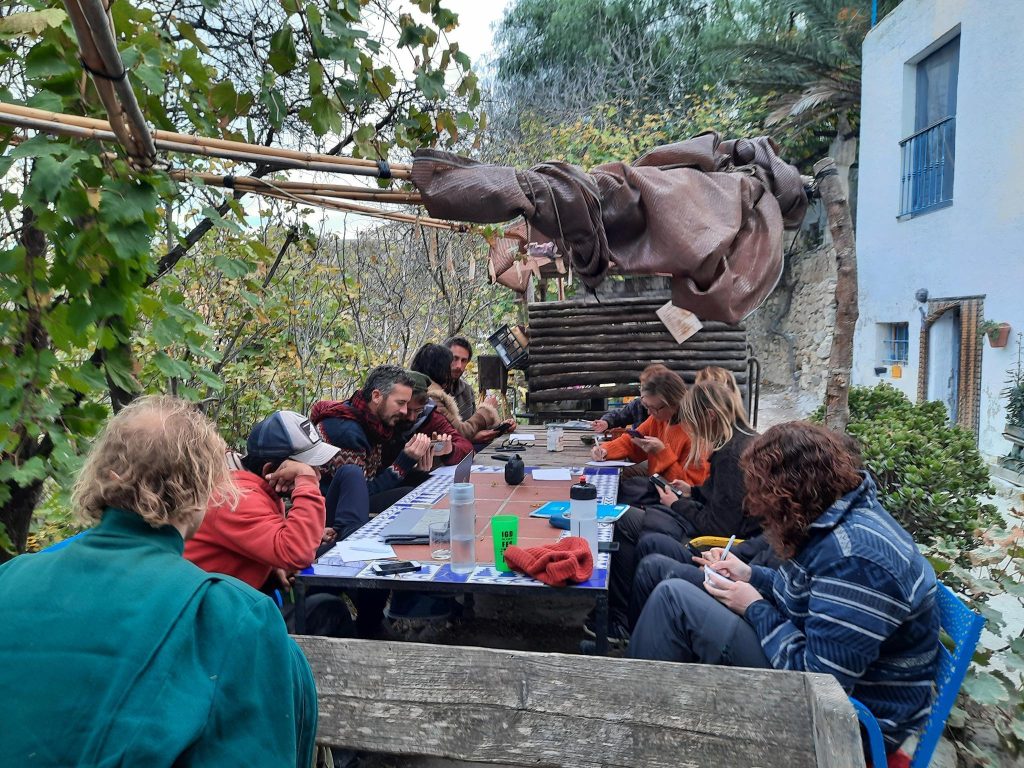Communication and Education
COP28 & Debt for Climate
Education interns Kira Börner and Jana Westerhaus write about their educational activity regarding COP28 and the necessity of debt cancellation for the global South[1] as part of our fight for climate justice.
What is the COP?
COP stands for Conference of the Parties and includes countries that signed the original UN climate agreement in 1992, also known as the United Nations Framework Convention on Climate Change (UNFCCC). The mission of the COP is to find collective solutions to stop global warming or at least limit temperature rise to a maximum of 2 degrees Celsius. We started our educational activity with a short role play where we teamed up in pairs to investigate the achievements of the past most important COPs. Every duo got to research about one past COP and had to prepare a short pitch of why next year’s COP should take place in their country again.
Important COPs
* Setting rights for the whole world for educational development
* First agreement on reducing emissions
* First agreement on protecting biodiversity
* Agreements on sustainable forest principles
* Agreements on fighting desertification
COP3 in Kyoto. (1997) Kyoto-Protocol
* Commitment of industrialized countries and economies in transition to limit and reduce (5,2% according to 1990) greenhouse gases and emissions in accordance with agreed individual targets until 2012. Agreement on flexible mechanisms – Joint-implementation – Clean Development – Emission Trade (ways of emission trades under different conditions)
* It works in terms of supporting more investment in projects abroad. The idea was that both parties would benefit from that. On one hand the receiving country takes advantage of, for example, given technologies and the money they would get for selling their emission rights. On the other hand, the investing country gains rights of emissions. (Mechanisms are concepts to support projects abroad. Through the emission trading, investing countries can count the emissions which have been cut in the receiving countries on their account. The Background: Reducing emissions where it is the cheapest, doesn’t matter where) (2005 the Kyoto-protocol started in its first period until 2012)
COP15 in Copenhagen (2009)
* High expectations on this one. Trying to extend Kyoto, the parties couldn’t agree, voluntary agreements.
* Global north agreed on mobilizing 100 billion dollars from 2020 every year to support the global south. Be aware of language here! Mobilizing!
COP18 in Doha (2012) and Kyoto II
* Tracking of achievements from Kyoto I
* Kyoto got extended until 2020 (US was never part of the agreement, Japan, Canada, New Zealand and Russia quit the agreement (the biggest emitters; with the leftover parties in the agreement responsible for “just” 15% of the global emissions).
COP21 in Paris (2015)
* Kyoto-agreement is ending 2020.
* New climate agreement was arranged (Paris agreement)
* Including the 17 Development goals (Backbone for Paris agreement, common thread for 1,5°C limit)
* First international agreement for global north and global south including supporting each other in achieving the goals.
* Celebrated big in the world, but agreements were non-binding, with no consequences for not achieving…
COP27 Scharm el-Sheikh (Egypt 2022)
* Loss and damage fund was created (refers to the measures that we take to help a country to get back on its feet after being hit by a climate action).
* Stepstone in admitting that the countries that are suffering the most from climate change should get supported by everyone, because everyone and especially the global north has contributed the most to the climate crises.
After the pitches, we dived into the agenda items of this year’s COP28, held in Dubai. The following items are being discussed there: climate change mitigation, adaptation, loss and damage fund, fossil fuel phase out, and how to finance all the previous items. Additionally, we also talked about the controversy of holding the COP28 in the United Arab Emirates (UAE), one of the world’s top 10 oil producing nations that even now wants to increase its oil production. When it comes to the agenda item ‘loss and damage fund’, one has to know that 75% of the money that is supposed to help global South countries to deal with the climate crisis comes in the form of loans instead of grants. Moreover, the amount of money that is supposed to be paid (roughly 100 billion) is not even enough to cover all the costs related to the climate crisis. It’s estimated that by 2030, the global South will need around 350 billion US dollars every year to adapt to the climate crisis. Hence, global South countries have to pay for adapting to a crisis that they did not even cause themselves while global North countries and corporations continue to profit[2]. Due to that, the second half of our info session was about the necessity of debt cancellation for global South countries.

What is debt?
Every past culture had exchange going on, meaning that there is debt and credit: someone owes and someone else is owed. This process is underpinned by a sense of fairness and reciprocity and societies had mechanisms in place that would keep inequalities in check. When inequalities increased, debt forgiveness and redistribution of land were common actions to take; this was known, for example, as Jubilee in the Bible and also within many Jewish communities. At some point wealthy individuals began to demand interest when lending money, an extra amount of money for the service and risk of lending. There are two important differences to understand when it comes to the payment of interest: 1. Simple interest which is payment based on a percentage of the saved or borrowed amount and which stays the same over time. 2. Compound interest which is not just based on the saved or borrowed amount, but also on the interest already earned so far. It’s “interest on interest” which is why a borrower can end up paying back way more than the initial loan, simply because the interest accumulates over time.
How is debt linked to colonialism?
It’s crucial to grasp that debt is all about power. Check out this video and document if you want to learn more about the interlinkages of debt and colonialism. The brief summary of it is that colonising nations benefited tremendously from exploiting peoples and nature in the global South and this exploitative system is still in place. Our global system is still organised along racist, colonial and capitalist lines and debt is just one of many tools used to maintain these structures. Former colonies were forced to compensate former colonisers for the ‘loss of their colonies’ after many global South countries gained independence. Additionally, many global South countries inherited debt accumulated by colonial powers during their time of rule and from dictators propped up by Western governments after the fight for independence. European powers transformed global South economies fit for export to feed the capitalist system in the West with cheap labour and resources. Many global South economies are still organised around this, making them very vulnerable to falling market prices. As stated by Jason Hickel in his book ‘The Divide – A brief guide to global inequalities and its solutions’ (2017), poverty gets created and doesn’t just exist in a vacuum. Hence, we need to understand why certain countries are rich and others are poor. Oftentimes the dominant narrative is that the debt of global South countries is purely a technical/financial issue or that it would all be due to “corrupt” or “incompetent” governments. But this narrative completely erases the role that colonialism and capitalism had in indepting these countries and how, up to this day, many powerful actors use debt as a means to extract wealth and to exercise control.
Who are the powerful actors that benefit from this debt system?
Two of the most important institutions are the World Bank and the International Monetary Fund (IMF). Both were set up in 1944 to create a more stable global economic system after the Second World War. The purpose of the World Bank was to finance the reconstruction and development of war-torn Europe, hence, focusing more on the long-term development of countries. The IMF’s focus was rather on short-term crisis response by having its focus on financing state spending in countries that were experiencing economic turmoil. However, this focus shifted in the 1980s when the West discovered its power as creditors that would enable them to dictate economic policies that wouldn’t threaten their access to cheap labour and resources.Many newly independent global South countries had presidents that wanted to protect their countries from external exploitative influences and started pursuing their own agendas to build thriving economies. As also mentioned by Hickel[3], during the period from the 1950-1970s, global South countries were flourishing and the divide between rich and poor countries was closing for the first time in history. This undermined profits of Western corporations and geopolitical interests of the global North, which is why the West overthrew and assassinated several democratically elected global South leaders to replace them with dictators, friendly to Western interests. When the price of goods crashed in the 1980s, several global South countries whose economies were still strongly focused on export due to previous times of colonialism, struggled repaying their loans. The West decided to repurpose the IMF as a global debt enforcer: the IMF would ‘support’ the global South in repaying their debt under a series of conditions known as “Structural Adjustment Programmes” (SAPs). SAPs consisted of austerity measures, privatisation and trade liberalisation.
These reforms were sold as enhancing the development of the global South, but they ended up being “the greatest single causes of poverty in the global South, after colonialism” (Hickel, ibid.). The World Bank began to require SAPs as well for all their development loans for global South governments, regardless of whether a country was indebted or not[4]. Lacking enough capital to make their countries prosper after being drained for centuries by colonial powers, many global South governments didn’t have much of a choice but to borrow money from the World Bank and the IMF. Both institutions have been and still are driven by US interests and remain global key decision makers that are dominated by global North powers.
Here a brief list of several ‘fun’ facts about both institutions:
* The voting power in both the World Bank and IMF is based on each member nation’s share of financial ownership and major decisions require a 85% majority vote. Guess who holds 16% of the shares in both institutions and therewith has de facto veto power? Right, the United States.
* Both institutions are headquartered in Washington D.C.
* There is the unspoken agreement that the president of the World Bank is always American whereas the IMF’s president is always European.
* Plus one should assume that the World Bank’s presidents are development experts since that’s supposedly the focus of this institution. But they all have/had links to the US government/army, Wall Street or other multinationals. Extra highlight: except one president, they were also all White men.
Over the last decade, more and more private creditors have entered the scene, such as banks, hedge funds and oil traders. Some of the famous ones are BlackRock, Vanguard and Vulture Funds. Around half of the global South debt is now in the hands of private lenders. So who owes whom? Looking at all these facts, it becomes clear that it is actually the global North that owes a debt to the global South for the exploitation and destruction of people and nature, plus the appropriation of our atmospheric commons by being responsible for most Greenhouse Gas (GHG) emissions that are causing climate breakdown. But so far the global North continues to ignore its historic responsibility and most climate crisis support comes (again) in the form of loans. Due to that debt cancellation is a crucial step in our fight for climate justice!
The global South has been calling for a democratisation of the World Bank and the IMF for decades but keeps getting ignored. This video also features a ‘great’ example from just a few days ago, showing how the EU rejects a fair global financial tax regime.
Debt for Climate
That’s why we need a global movement, putting pressure on governments, private lenders, corporations and powerful institutions such as the World Bank and the IMF. Debt for Climate is doing exactly that – it’s a global grassroots movement initiated and led by the global South, building power from the bottom-up by uniting workers, Indigenous, feminist, faith, environmental, social and climate justice movements in the global North and South, to cancel the financial debt of the global South in order to enable a self-determined, just transition.
Here are some impressions from their past actions, so check them out:
–> Global Mobilization of Debt for Climate October 2023 – YouTube
–> Debt for Climate on X: “💥Our video from the last global action is out!💥 We continue to grow and are coming together again to step up the game this month! Join us to turn the tables on financial colonialism Feb 27th, and hold the global North accountable for its #ClimateDebt towards the global South! https://t.co/vTdKzsLm4E” / X (twitter.com)
__________________________________________________________________
[1] The terms global North and global South don’t refer to geographic locations of countries. Rather they encompass the relative power and wealth countries have in the world. Global North countries (such as the UK, US, Canada, Australia, Japan and many European countries) have power and wealth, while global South countries (including many formerly colonised countries in Africa, Latin America, the Middle East and Asia) have less power and wealth on a global scale.
[2] An article about debt relief in relation to COP28: New push for debt relief to help developing world fund climate action | Climate finance | The Guardian
[3] From the book The Divide – A brief guide to global inequalities and its solutions by Jason Hickel, 2017, p.22.
[4] The IMF’s focus was on supposedly helping countries deal with over-indebtedness while the World Bank’s focus should have been to support the global South in their ‘development’.


